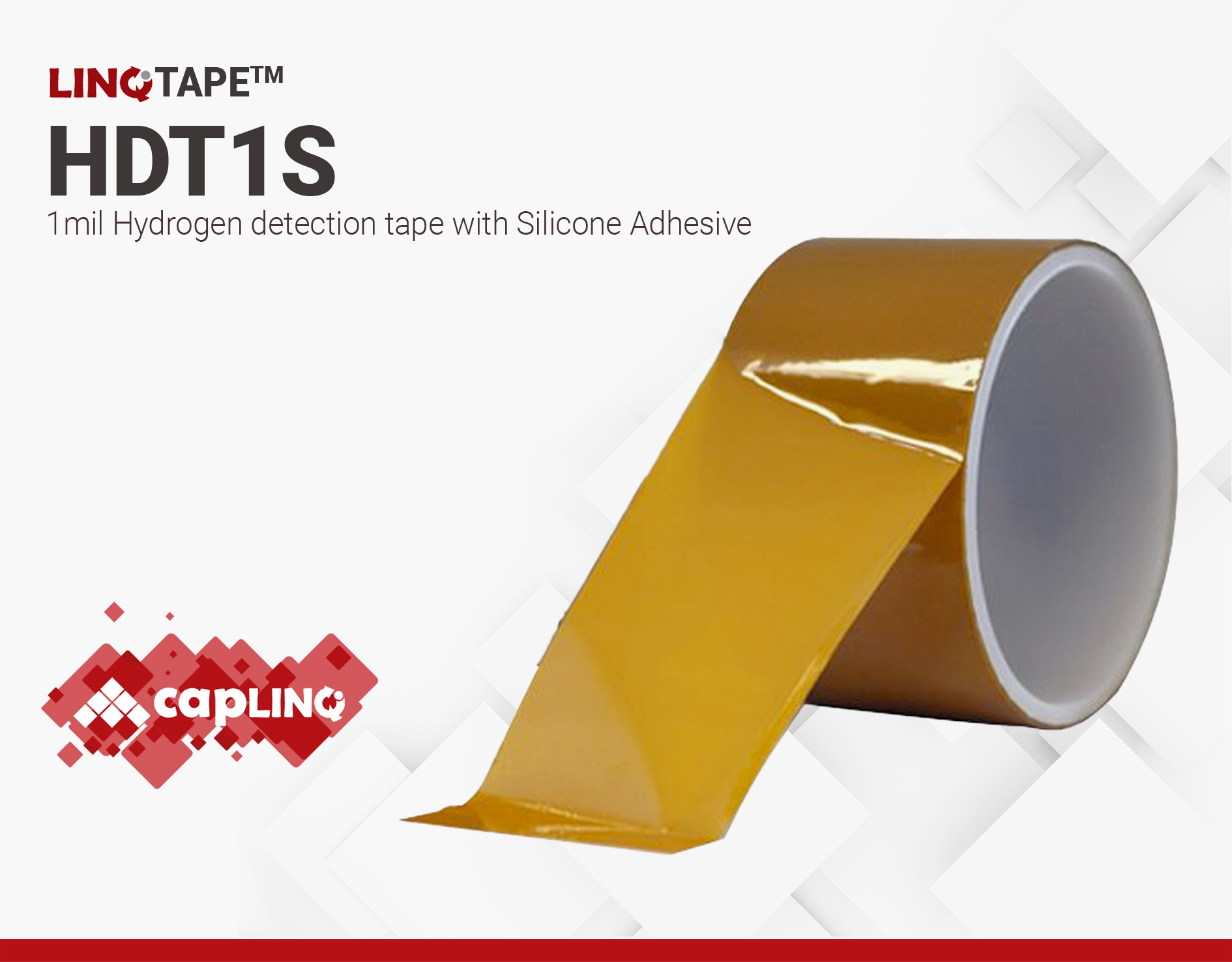LINQTAPE HDT1S | Hydrogen detection tape
- 1 and 2 inch Options
- Visual H2 leak detection
- Fast and reliable for H2 storage and transportation
Product Description
LINQTAPE HDT1S is an advanced solution for the visual detection of hydrogen gas leaks. This tape undergoes a rapid color change – transitioning from amber to black in as little as 10 seconds when exposed to hydrogen gas. The speed of this color transformation is contingent on factors like flow rate, temperature, time, and hydrogen percentage.
LINQTAPE HDT1S provides an effective means of detecting gas leaks, significantly improving response time by facilitating the identification of intermittent leaks. Its high sensitivity allows it to detect hydrogen leaks with concentrations as low as 1% H2, making it a reliable safety net in various applications. Once exposed to hydrogen gas, LINQTAPE HDT1S maintains its altered color permanently, ensuring a lasting indication of exposure. Applying this tape is a seamless process, akin to typical silicone/polyimide PSA (Pressure Sensitive Adhesive), making it user-friendly.
LINQTAPE HDT1S can be used in a variety of indoor or outdoor environments. It outperforms conventional portable or stationary sensors, offering superior detection and precise identification of hydrogen leak locations. This tape is less influenced by external factors such as wind, position, duration, or user skills. It provides comprehensive visibility, allowing for easy inspection of vertical and bottom faces.
Key Features:
- Reliable hydrogen gas detection
- Can detect concentrations as low as 1%
- Color changing for ease of use
- Countless applications
Technical Specifications
| General Properties | |||||
| Adhesive Thickness Adhesive Thickness Adhesive thickness indicates the thickness of an adhesive layer. It refers to the adhesive thickness of a single side so for double sided tapes it always needs to be multiplied. | 35.36 µm | ||||
| Color Color The color | Amber | ||||
| Film Thickness Film Thickness Film thickness is the thickness of a backing film without taking into account any coatings or adhesive layers. It is measured in micron and the conversion factor to mil is 0.039. | 25.4 µm | ||||
| Total Thickness Total Thickness Total thickness is taking into account all the films, coatings, adhesives, release liners and special layers and is the maximum thickness of a film or tape. | 60.96 μm | ||||
| Mechanical Properties | |||||
| Adhesion Strength Adhesion Strength Adhesion is the bond strength measurement of a coating to a substrate. When an adhesive is bonded to an item or surface, numerous physical, mechanical and chemical forces come into play, which may have an effect on each other. | 18 Oz/in | ||||
| Elongation Elongation Elongation is the process of lengthening something. It is a percentage that measures the initial, unstressed, length compared to the length of the material right before it breaks. It is commonly referred to as Ultimate Elongation or Tensile Elongation at break. | 67 % | ||||
| |||||
| Thermal Properties | |||||
| Temperature Range | 60 °C | ||||
| Other Properties | |||||
| RoHS Compliant RoHS Compliant RoHS is a product level compliance based on a European Union Directive which restricts the Use of certain Hazardous Substances in Electrical and Electronic Equipment (RoHS). Products compliant with this directive do not exceed the allowable amounts of the following restricted materials: lead, mercury, cadmium, hexavalent chromium, polybrominated biphenyls (PBB) and polybrominated diphenyl ethers (PBDE), with some limited exemptions | Yes | ||||
Additional Information
Applications:
Power and chemical plants.
Transportation markets.
Hydrogen Co-Generators.
Fuel stations.
Storage tanks and compressors.
New energy markets and more.
Application Ideas:
Easily applied to or wrapped around pipes, flanges, fittings, valves, access panels, etc., providing immediate identification of precise hydrogen leak locations.
Permanent Color Indication: Identifies leak locations even if the hydrogen line is shut off.
What happens if these tapes are exposed to higher temperatures?
LINQTAPE HDT1S is a Polyimide tape with a Silicone adhesive that is reactive to Hydrogen. When it comes to materials, this is very similar to our PIT1S so the operating temperature is 260°C. The problem lies with the reactive nature of the tape. The higher the temperature, the lower the time it takes to detect H2. Since some Hydrogen applications are in the negative °C, we know that it will take much, much longer for the tape to react at cryo temperatures.
On the upper limit, we have tested it for 6 months at 60°C and it works fine. We don't know how the tape would react in higher temperatures though. Technically, the materials should be OK but the high temp will probably affect the reactivity and cause all kinds of issues. The entire idea with H2 detection tapes is really to prevent things such as jet fire from happening by regular monitoring. In theory, we expect the tape to react since H2 will be present and the temperature caused by the jet fire will accelerate the reaction. In practice, we don't know.
it is important to note that the tape WILL react even with a very low % of H2 in the air (even 1% will suffice). It will just take much longer (hours) than if there were higher concentrations where you would expect a color change within a couple of minutes.



